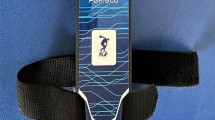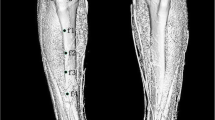Abstract
Purpose
This study proposes a simple and noninvasive instrument called the “Rotatometer” to measure tibiofemoral rotation and investigates its clinical applicability to the assessment of static rotational knee laxity.
Methods
The degree of tibiofemoral rotation was measured for a sample of 94 healthy volunteers with 188 knees by using the Rotatometer. The measurement was made by two independent and blinded examiners in three sessions at one-month intervals. The normative rotational profile and its relationship with gender and age were evaluated, and inter-observer reliability and intra-observer reliability were calculated.
Results
Males showed 62° ± 5° of external rotation, whereas females, 64° ± 5°. Males showed 44° ± 5° of internal rotation, whereas females, 49° ± 4°. Females showed significantly higher degrees of rotation than males. Tibiofemoral rotation was not correlated with age, and external rotation and internal rotation had a moderate positive relationship. Inter-observer reliability ranged from 0.84 to 0.91 for external rotation and 0.90 to 0.95 for internal rotation, and intra-observer reliability ranged from 0.69 to 0.89 for external rotation and 0.87 to 0.95 for internal rotation.
Conclusions
The results suggest the Rotatometer to be a simple and noninvasive device with high inter- and intra-observer reliability. The device can provide a normative rotational profile for reference purposes and thus can be used to determine the preoperative and postoperative rotational status of knees with anterior cruciate ligament injuries and compare results from different reconstruction techniques.
Level of evidence
Diagnostic study, Level III.


Similar content being viewed by others
References
Alam M, Bull AM, Thomas RD, Amis AA (2013) A clinical device for measuring internal-external rotational laxity of the knee. Am J Sports Med 41:87–94
Almquist PO, Arnbjornsson A, Zatterstrom R, Ryd L, Ekdahl C, Friden T (2002) Evaluation of an external device measuring knee joint rotation: an in vivo study with simultaneous Roentgen stereometric analysis. J Orthop Res 20:427–432
Ayeni OR, Chahal M, Tran MN, Sprague S (2012) Pivot shift as an outcome measure for ACL reconstruction: a systematic review. Knee Surg Sports Traumatol Arthrosc 20:767–777
Balasch H, Schiller M, Friebel H, Hoffmann F (1999) Evaluation of anterior knee joint laxity with the Rolimeter. A test in comparison with manual assessment and measuring with the KT-1000 arthrometer. Knee Surg Sports Traumatol Arthrosc 7:204–208
Branch TP, Browne JE, Campbell JD, Siebold R, Freedberg HI, Arendt EA, Lavoie F, Neyret P, Jacobs CA (2010) Rotational laxity greater in patients with contralateral anterior cruciate ligament injury than healthy volunteers. Knee Surg Sports Traumatol Arthrosc 18:1379–1384
Branch TP, Siebold R, Freedberg HI, Jacobs CA (2011) Double bundle ACL reconstruction demonstrated superior clinical stability to single-bundle ACL reconstruction: a matched-pairs analysis of instrumented tests of tibial anterior translation and internal rotation laxity. Knee Surg Sports Traumatol Arthrosc 19:432–440
Colombet P, Robinson J, Christel P, Franceschi JP, Djian P (2007) Using navigation to measure rotation kinematics during ACL reconstruction. Clin Orthop Relat Res 454:59–65
Daniel DM, Malcom LL, Losse G, Stone ML, Sachs R, Burks R (1985) Instrumented measurement of anterior laxity of the knee. J Bone Joint Surg Am 67:720–726
Ganko A, Engebretsen L, Ozer H (2000) The rolimeter: a new arthrometer compared with the KT-1000. Knee Surg Sports Traumatol Arthrosc 8:36–39
Jakob RP, Staubli HU, Deland JT (1987) Grading the pivot shift. Objective tests with implications for treatment. J Bone Joint Surg Br 69:294–299
Jonsson H, Riklund-Ahlstrom K, Lind J (2004) Positive pivot shift after ACL reconstruction predicts later osteoarthrosis: 63 patients followed 5–9 years after surgery. Acta Orthop Scand 75:594–599
Kocher MS, Steadman JR, Briggs KK, Sterett WI, Hawkins RJ (2004) Relationships between objective assessment of ligament stability and subjective assessment of symptoms and function after anterior cruciate ligament reconstruction. Am J Sports Med 32:629–634
Lee S, Kim H, Jang J, Seong SC, Lee MC (2012) Comparison of anterior and rotatory laxity using navigation between single- and double-bundle ACL reconstruction: prospective randomized trial. Knee Surg Sports Traumatol Arthrosc 20:752–761
Lorbach O, Brockmeyer M, Kieb M, Zerbe T, Pape D, Seil R (2012) Objective measurement devices to assess static rotational knee laxity: focus on the Rotameter. Knee Surg Sports Traumatol Arthrosc 20:639–644
Lorbach O, Kieb M, Brogard P, Maas S, Pape D, Seil R (2012) Static rotational and sagittal knee laxity measurements after reconstruction of the anterior cruciate ligament. Knee Surg Sports Traumatol Arthrosc 20:844–850
Lorbach O, Wilmes P, Maas S, Zerbe T, Busch L, Kohn D, Seil R (2009) A non-invasive device to objectively measure tibial rotation: verification of the device. Knee Surg Sports Traumatol Arthrosc 17:756–762
Lubowitz JH, Bernardini BJ, Reid JB 3rd (2008) Current concepts review: comprehensive physical examination for instability of the knee. Am J Sports Med 36:577–594
Lustig S, Magnussen RA, Cheze L, Neyret P (2012) The KneeKG system: a review of the literature. Knee Surg Sports Traumatol Arthrosc 20:633–638
Mayr HO, Hoell A, Bernstein A, Hube R, Zeiler C, Kalteis T, Suedkamp NP, Stoehr A (2011) Validation of a measurement device for instrumented quantification of anterior translation and rotational assessment of the knee. Arthroscopy 27:1096–1104
McQuade KJ, Sidles JA, Larson RV (1989) Repeatability of the Genucom knee analysis system. A pilot study. Clin Orthop Relat Res 245:216–219
Mouton C, Seil R, Agostinis H, Maas S, Theisen D (2012) Influence of individual characteristics on static rotational knee laxity using the Rotameter. Knee Surg Sports Traumatol Arthrosc 20(4):645–651
Mouton C, Theisen D, Pape D, Nührenbörger C, Seil R (2012) Static rotational knee laxity in anterior cruciate ligament injuries. Knee Surg Sports Traumatol Arthrosc 20:652–662
Musahl V, Bell KM, Tsai AG, Costic RS, Allaire R, Zantop T, Irrgang JJ, Fu FH (2007) Development of a simple device for measurement of rotational knee laxity. Knee Surg Sports Traumatol Arthrosc 15:1009–1012
Noyes FR, Grood ES, Cummings JF, Wroble RR (1991) An analysis of the pivot shift phenomenon. The knee motions and subluxations induced by different examiners. Am J Sports Med 19:148–155
Park HS, Wilson NA, Zhang LQ (2008) Gender differences in passive knee biomechanical properties in tibial rotation. J Orthop Res 26:937–944
Plaweski S, Cazal J, Rosell P, Merloz P (2006) Anterior cruciate ligament reconstruction using navigation: a comparative study on 60 patients. Am J Sports Med 34:542–552
Schulz MS, Russe K, Lampakis G, Strobel MJ (2005) Repeatability of stress radiography for evaluation of posterior knee laxity. Am J Sports Med 33:502–506
Shoemaker SC, Markolf KL (1982) In vivo rotatory knee stability. Ligamentous and muscular contributions. J Bone Joint Surg Am 64:208–216
Shultz SJ, Shimokochi Y, Nguyen AD, Schmitz RJ, Beynnon BD, Perrin DH (2007) Measurement of varus–valgus and internal–external rotational knee laxities in vivo—Part I: assessment of measurement repeatability and bilateral asymmetry. J Orthop Res 25:981–988
Snyder-Mackler L, Fitzgerald GK, Bartolozzi AR, Ciccotti MG (1997) The relationship between passive joint laxity and functional outcome after anterior cruciate ligament injury. Am J Sports Med 25:191–195
Sorensen OG, Larsen K, Jakobsen BW, Kold S, Hansen TB, Lind M, Soballe K (2011) The combination of radiostereometric analysis and the telos stress device results in poor precision for knee laxity measurements after anterior cruciate ligament reconstruction. Knee Surg Sports Traumatol Arthrosc 19:355–362
van der Hart CP, van den Bekerom MP, Patt TW (2008) The occurrence of osteoarthritis at a minimum of ten years after reconstruction of the anterior cruciate ligament. J Orthop Surg Res 10(3):24
Wang CJ, Walker PS (1974) Rotatory laxity of the human knee joint. J Bone Joint Surg Am 56:161–170
Woo SLY, Fisher MB (2009) Evaluation of knee stability with use of a robotic system. J Bone Joint Surg Am 91:78–84
Zaffagnini S, Bignozzi S, Martelli S, Imakiire N, Lopomo N, Marcacci M (2006) New intraoperative protocol for kinematic evaluation of ACL reconstruction: preliminary results. Knee Surg Sports Traumatol Arthrosc 14:811–816
Zantop T, Herbort M, Raschke MJ, Fu HF, Petersen W (2007) The role of the anteromedial and posterolateral bundles of the anterior cruciate ligament in anterior tibial translation and internal rotation. Am J Sports Med 35:223–227
Acknowledgments
All authors have read and approved submission of the manuscript, and we have confirmed that all authors fulfilled conditions required for authorship. This manuscript has not been published and is not being considered for publication elsewhere in whole or in part in any language. This study was approved by the Institutional Review Board (IRB). No financial support was received.
Author information
Authors and Affiliations
Corresponding author
Rights and permissions
About this article
Cite this article
Chung, J.H., Ryu, K.J., Lee, D.H. et al. An analysis of normative data on the knee rotatory profile and the usefulness of the Rotatometer, a new instrument for measuring tibiofemoral rotation: the reliability of the knee Rotatometer. Knee Surg Sports Traumatol Arthrosc 23, 2727–2733 (2015). https://doi.org/10.1007/s00167-014-3039-9
Received:
Accepted:
Published:
Issue Date:
DOI: https://doi.org/10.1007/s00167-014-3039-9




